Secwépemc Elder, a veteran of the powwow circuit, has built a legacy through dance
On an afternoon in April, Secwépemc Elder Peter Anthony is sitting in his living room, surrounded by photos of himself and his family adorned in regalia at various powwows.
Today, he is dressed casually, wearing jeans and a plaid button up shirt as the news plays on the TV in the background. But his 40 years of dance experience is immortalized throughout the house, and powerful energy radiates from the images and pieces such as an eagle feather bustle that hangs on the wall.
“I’ve always made my own outfits,” he explains.
“I never ever depended on anybody to do that for me, it gives me more pride that I made this.”
Anthony lives at Adams Lake Indian Band in “Chase, B.C.” where he owns and operates a log building company, Sky Eagle Log Homes. But what most people know him from is his dancing. Every year from May until September, Anthony travels on the powwow circuit, attending a new event almost every weekend.
Over his long dance career — spanning four decades — Anthony has become a champion on the powwow circuit, competing in the men’s traditional category while learning steps to each dance along the way.
Reclaiming culture
As a child, Anthony says he was chosen by community leaders to learn and engage in his culture. He recalls going up mountains and hearing about the medicines available and learning the Secwépemc ways while walking, riding horses and hunting.
“I went to residential school and a lot of that got taken away,” he says.
As a Sixties Scoop and residential “school” survivor, Anthony notes he went through hardship that extended throughout his teens and twenties, which led him to getting into trouble and ending up in prison.
“In my younger days I went through a lot and I ended up doing a lot of drinking in my younger days and partying around,” he says.
Through his time at residential “school” and in non-Indigenous houses throughout his childhood as a victim of the Sixties Scoop, Anthony lost his connection to the culture. He began drinking in his early teens and that connection stayed hidden until much later in his life.
Anthony then went to the Round Lake Treatment Centre where he began drumming and singing. He had heard the music before in the community, but this was his first experience being engaged with the songs. He began to remember his Secwépemc culture.
On the day of his graduation from the program, Anthony was surprised by his brothers. They had heard about his new knowledge of the songs and recruited him into a drum group.
For years, Anthony was a member of the Painted Eagle drum group that travelled around to sing at powwows. After singing for years, his friend and fellow drum group member John Jules mentioned that he should try powwow dancing.
Anthony remembers saying: “I don’t want those folks looking at me, everybody’s going to look at me, I don’t want to go out there and embarrass myself.”
He recalls Jules pointing out that everyday people look, and he asked Anthony what he was so worried about. Jules found regalia and a bustle for him to use, and the Lillooet powwow was the first time Anthony tried dancing. Almost immediately he knew that he wanted to continue on.
He started building his own regalia — collecting feathers, beading, and putting it all together to create a personalized, intricate and unique outfit.
Each element of the powwow, including the regalia, is considered sacred and Anthony ensures that he keeps that integrity while in his outfit.
“I respect the spirit of my feathers and I respect the spirit of my outfit,” he says.
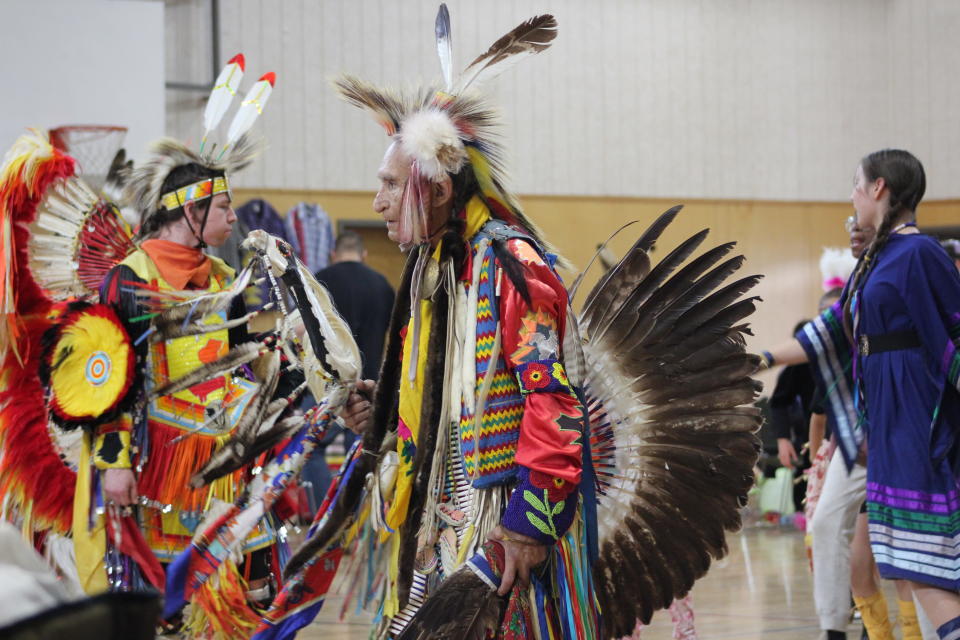
That first powwow was about four decades ago, and from then on he has been committed to dancing and has never stopped. To this day, Anthony still creates all of his outfits by hand. He learned to put bustles together with eagle feathers — which takes years as he collects each feather over time and is also gifted them. He uses porcupine hair to create a roach, and beads detailed designs to adorn his outfit.
“It comes attached to you a lot better when you do it yourself, and I just dance better with my own outfit,” he says.
Anthony notes he started attending every powwow in the area, never missing a weekend. For four years he was singing and dancing with his original drum group until the other members began slowing down, but Anthony wanted to keep going.
“I kept going to powwows every weekend and it helped to keep me sober and it helped me to keep my life straight and narrow,” he says.
Eventually, Anthony began travelling farther and ended up attending powwows in “Alberta,” “Saskatchewan,” “Manitoba,” and the “United States.” Anthony has danced in front of large crowds at events such as the Gathering of Nations powwow, which can have up to 100,000 visitors per year and even more spectators through their online broadcast.
Building a legacy
Anthony notes that it wasn’t until he was around 45 years old that he began winning the contest dances at powwows.
“From all that practice and everything I got recognized,” he says.
After placing in second and third place Anthony used his winnings to travel even more, giving him more opportunities to dance. It took another five years — when Anthony was 50 years old — for him to start winning first place.
“Things got better then because then I had money to travel around after I would win,” he says.
Dancers tend to follow the same powwow circuits and Anthony had a group of dancers — who were fellow champions — who he would travel side by side with. They would camp near the powwow and dance through each day.
“Powwowing has been my life for 40 years and it has brought me a long way,” he says.
“I still dance and I’m still a champion.”
Even through COVID-19, Anthony continued dancing by entering virtual powwows.
He remarks that his contest wins have even helped to buy the house that he and his family live in. Some weekends, he recalls walking away with winnings of $5,000 to $6,000.
In the corner of the room trophies that he’s won over the years sit atop a cupboard.
He has had plenty of wins and been called a legend by other dancers — but he recalls being told not to brag and show off but to remain humble and ensure he is always dancing for the people.
He points out the window to an eagle flying above the Adams Lake Indian Band reserve against a cloudy backdrop, underscoring this reminder.
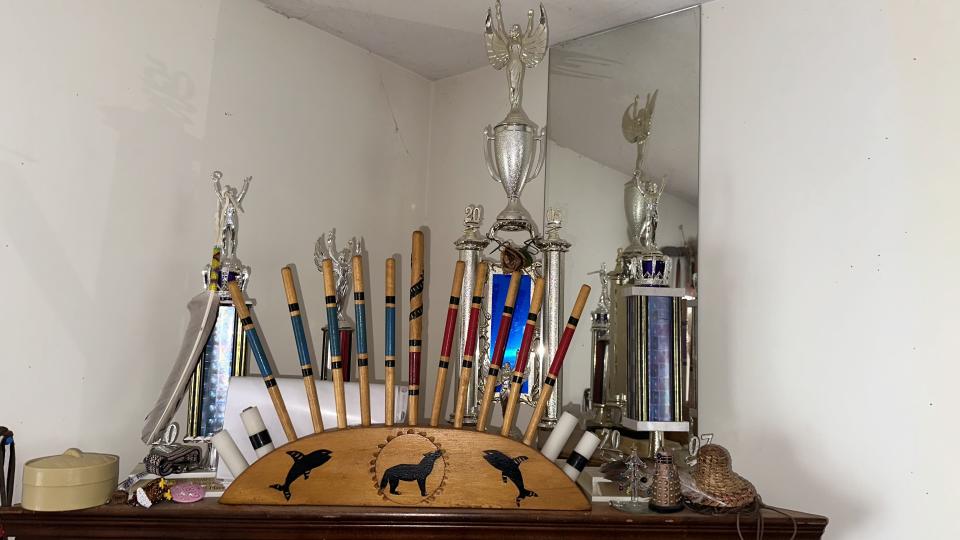
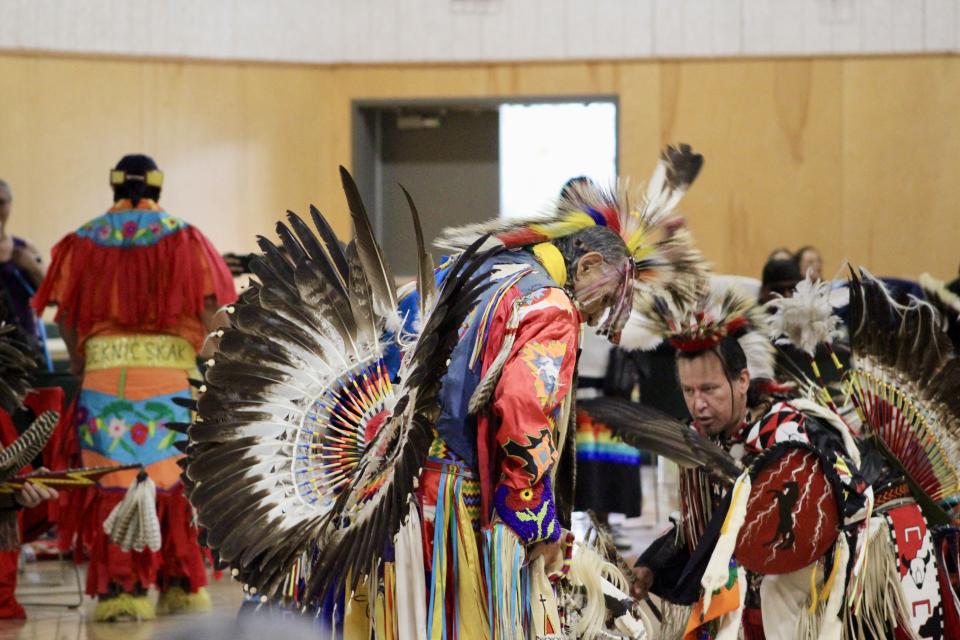
In early May, the second annual Rita Rose Anthony Powwow and Stick Games took place at the Adams Lake Indian Band community gym — an event organized by Anthony and his family as a memorial for his late wife.
Involved in the planning and execution of the powwow, Anthony was on the move throughout the event. During his small breaks between dancing, judging, and making announcements he was seated near the emcee where he had a view of the recreation gym where the powwow was held.
While judging the dances, he stood in the middle of the recreation gym as the dancers moved around him with the rhythm of the drums. After choosing the winners for a men’s category, Anthony joined them for a song as they danced around the room.
A smile stayed on Anthony’s face as he danced and celebrated with the winners. The multicoloured ribbons on his regalia swayed with each movement while the roach made of porcupine hair on his head bounced along to the beat of the drum.
For intertribal songs, where everyone is invited to dance, Anthony was in the circle where he danced to each drum’s song.
When the men’s traditional category came up Anthony was ready to dance. With a horse staff in his left hand and his eagle fan in his right hand he moved gracefully. Following the song and drum beat he danced with enthusiasm as his hands raised and he bowed when the songs called for the movement.
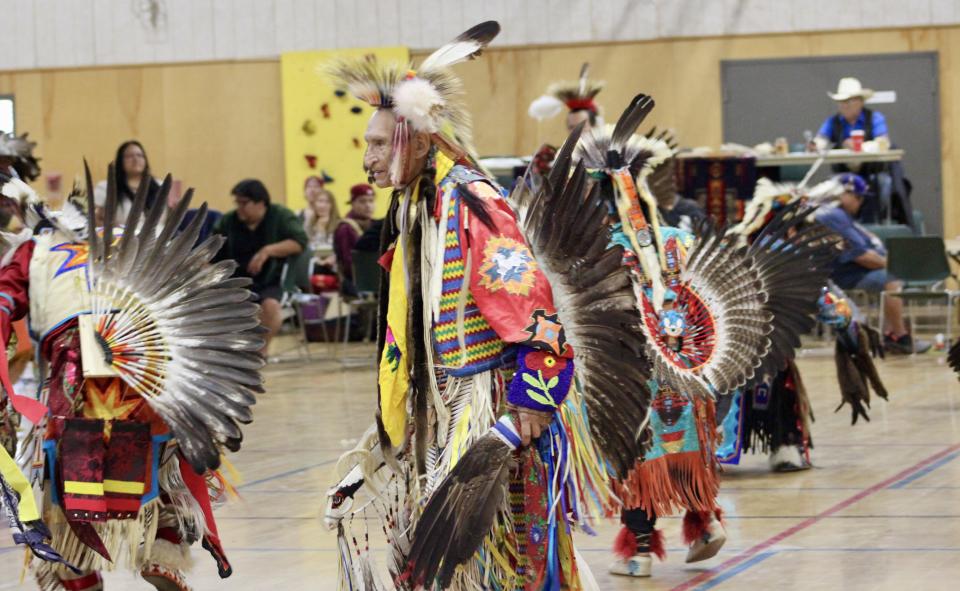
Trent Abraham, a fellow powwow dancer, met Anthony more than 20 years ago while on the powwow circuit and speaks highly about Anthony’s commitment to the dance.
“Whether it was hitchhiking or if he had a ride he’d still make it to those bigger gatherings and go there to dance; make it powwow to powwow,” says Abraham.
Anthony even inspired Abraham to take his own children on the powwow circuit and travel as much as he can since he regularly saw Anthony bring his children to events, including the powwows in Ts’il Kaz Koh (Burns Lake) which is Abraham’s home community.
At each powwow, Abraham notes that Anthony is willing to dance for each and every drum group and singer, a trait that he says not all dancers possess.
“Peter’s always showed respect to the drums and just danced, it didn’t matter who was singing,” he says.
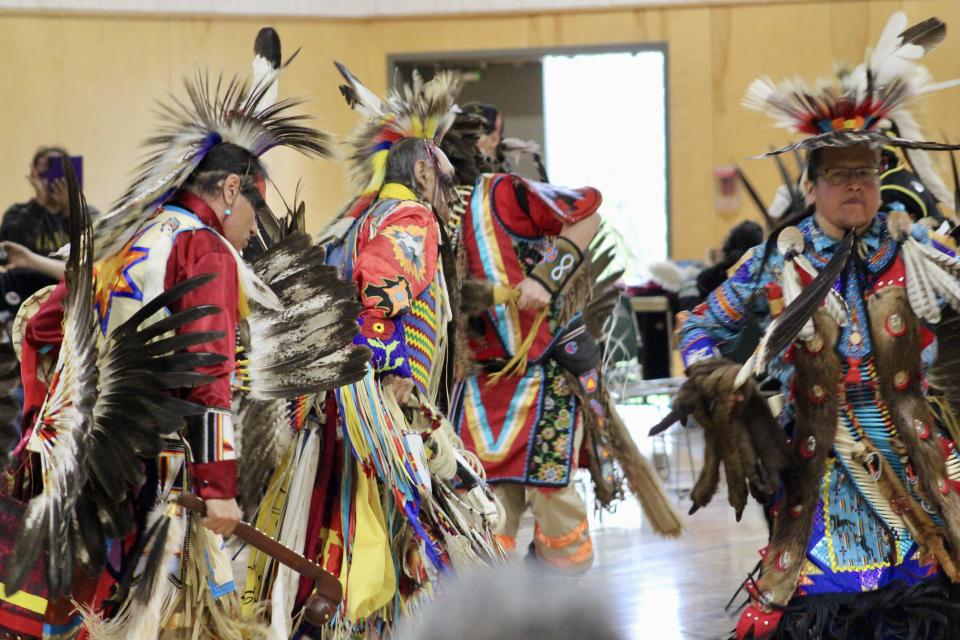
Dancing ‘shows me who I am’
Anthony had a heart attack at the beginning of this year and has recovered to where he can dance and he’s still as committed to attending powwows.
“I just started again so I’m not going to quit dancing — that’s not a question, quitting — I can’t, it’s in blood, it’s in my spirit,” he says.
There are many positives to Anthony’s dancing and he’s still going and not slowing down anytime soon.
“[Dancing] shows me who I am, shows me where I’m from and it’s a really good feeling to know that,” he says.
“One of the best things, I guess, out of this whole thing is how far it has taken me in life and where it has taken me in life.”
Dancing is a time where Anthony has learned to pray and he extends this to anyone who needs a prayer. He extends his prayers to ceremonies as well, using the sweat lodge in his backyard regularly.
Anthony hopes that anyone with knowledge of the culture and traditions will help the younger generations learn and embrace who they are.
At powwows he is always available to talk with young children who are interested in dancing. After watching him dance he’s heard children go tell their parents that they want a regalia and to dance just like him.
“They follow me around and they want to be like me, they want to dance like me so I show them,” he says.
“We’re still healing from residential schools, we’re still healing from the Sixties Scoop, we’re still healing from a lot of things that our people have gone through. But if we come together in gatherings, and we come together in powwows, then we can look at it as a victory.”
He notes that the younger generations should be proud of their culture and who they are while they are learning the Western ways in the school system.
“We can mix those two together so that our children can grow up strong, our children can grow up with the language, and our children can grow up with ceremony and grow up with all those types of things that they need to live in this world.”
Reporting for this story was made possible in part through funding from the Real Estate Foundation of BC, a philanthropic organization working to advance sustainable, equitable, and socially just land use across the province.
Dionne Phillips, Local Journalism Initiative Reporter, The Wren


